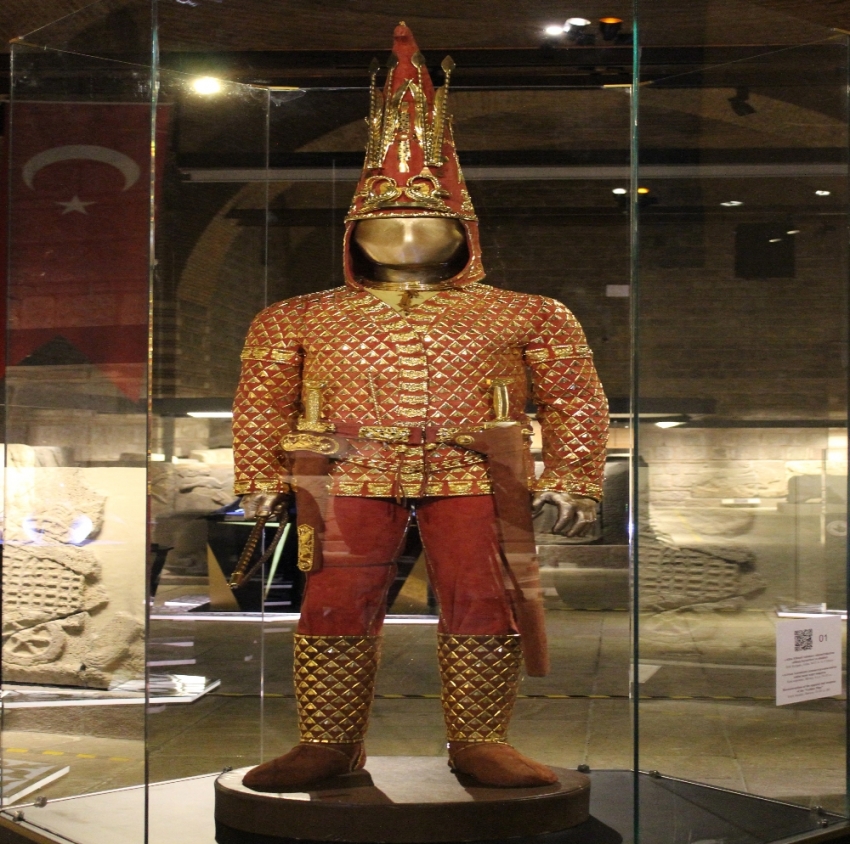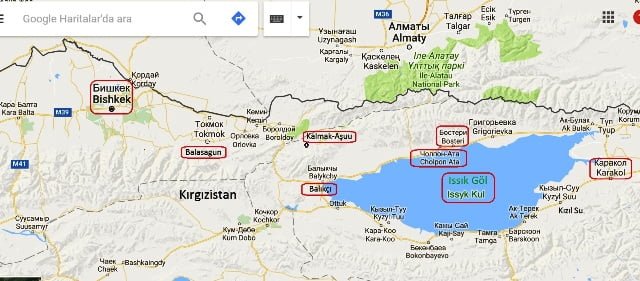türkçe links to original Turkish article
(Hürriyet Newspaper, 15 September 2019)
scythians click here for BBC background.

The 'Gold Dressed Armored Man' found at a construction site in
Kazakhstan and decorated with more than 3,000 pieces of hand-
worked gold has been brought to Turkey. The outfit is thought to have
belonged to a khan or his only son and is on display at the Anatolian
Civilizations Museum in Ankara until 12 October.
In 1969, the gold armored outfit was found in a 'kurgan' (burial mound)
6 meters high and 60 meters across in a construction site in the Yedisu
region of Kazakhstan. The more than 3,000 gold pieces of the outfit are
hand-worked with images of leopards, eagles, rams, deers, mountain
goats, horses and birds. The dress is made up of a short V-neck jacket
that closes from right to left, tight cavalry pants and boots that come up
halfway to the knees.
The hat is a 65 centimeter (25.5 inch) 'kalpak' (fur cap) with a mountain
goat motif at its point, 4 arrows that symbolize the ruler of the world and
2 winged horses that indicate worship of the sun god. For weaponry,
the outfit has a long iron sword inlaid with 150 gold pieces of various
sizes, a half-leather half-wooden dagger and a gold-worked whip. The
outfit's wearer also has a ring that serves as his seal.
The items found along with the gold armor at the gravesite, called Isık
Kurganı, indicate that the Turks established a great state and civilization
2,500 years ago and used their own written language. The two-line
message on a cup with a broken handle found in the grave is considered
the most ancient example of a Turkish text, which most experts say
means "The Khan's son died at age 23/may the mourning populace's
grief be soothed."
detailed info click here for a very in-depth analysis of the cup's
writing.

Kazakhstan's Ambassdor in Ankara, Abzal Saparbekuli, explained that
"the outfit's story is quite interesting. As the machines were being
operated for road construction, some gold pieces were uncovered next
to a big mound. Archeological excavations began and this outfit was
discovered. It is extremely important from the standpoint of the
period's gold working and spiritual values."
According to Saparbekuli, more than 4,000 items have been extracted
from the Isık Kurganı graves. Modern Kazakhstan's founder Nursultan
Nazarbaev calls the find "the 'Tutankhamun' of the Great Steppe" and,
in fact, the gold recovered from this grave is second only to that found
in Tutankhamun's grave. Saparbekuli added that "In other sites in
Kazakhstan, 5 golden men and women have been found. The treasures
are the heritage of the Scythians. The 'Golden Man' discovery shows
that our history dates not just from the Göktürks, but from the Huns and
the Sakas."
Ambassador Saparbekuli said that 207 treasures from 7 regions of
Kazakhstan are on display at the museum in Ankara and the exhibit
includes the cup with the most ancient Turkish writing on it. He
noted that "I invite our Turkish brothers, art-lovers, history-lovers
and all the people of Ankara to view the display up until 12 October
and get to know their homeland and history."

Isık Kurganı is in the town of Esik, top right-hand side of the
map, north of Kyrgyzistan's Lake Issık Göl on the Kazakhstan
side of their common border.

Hiç yorum yok:
Yorum Gönder